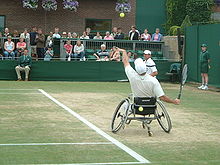Wheelchair tennis

Wheelchair tennis refers to tennis for wheelchair users . It is played essentially according to the known rules, with the exception that the players are allowed to bounce the ball twice before the stroke.
The sport has been a regular discipline of the Paralympic Games since 1992 . The four Grand Slam tournaments also have their own competitions for women and men in singles and doubles. Players who can only move their arms to a limited extent compete against each other in their own competition (so-called "Quad Singles" and "Quad Doubles"). The sports wheelchairs used for "quad" players can also have an electric drive.
history
Wheelchair tennis goes back to the American Brad Parks . After a skiing accident a paraplegic , he made in 1976 during the rehabilitation first experiments with tennis in a wheelchair. He met the wheelchair athlete Jeff Minnenbraker , with whom he developed the new sport and made it known.
In May 1977, the first tournament with 20 participants was held in the city park of Los Angeles .
In 1980, the first wheelchair tennis association, the National Foundation of Wheelchair Tennis (NFWT), was founded, and Parks elected David Saltz , Jim Worth and Dave Kiley to its board . The result was a series of 10 tournaments, including the first American championships, which were held in Irvine , California. The first winner was Brad Parks. At the end of the year there were around 300 wheelchair tennis players in the USA.
In 1981 the Wheelchair Tennis Players Association was founded . The French Jean-Pierre Limborg was the first time a non-American competed in the US championships. After his return, Limborg founded the first European wheelchair tennis club with his trainer in Garches . In the period that followed, the sport spread throughout Europe, so that in 1983 the “Open d'Antony” in Paris, the first international tournament in Europe, can be held.
In 1984 the wheelchair manufacturer Everest & Jennings in the USA succeeded in gaining a first sponsor for the tour. In the following year, the number of tournaments on American soil grew to 40, in which about 1,500 players took part. With the World Team Cup , a national competition based on the Davis Cup or Fed Cup was launched. The European Wheelchair Tennis Federation (EWTF) was founded in Europe and initiated a series of tournaments in Europe. In 1986 the first French championships took place in Antony .
In October 1988, the first international association, the International Wheelchair Tennis Federation (IWTF), was founded during the US Open . At the Paralympic Games in Seoul , wheelchair tennis was part of the program as a demonstration sport. It has been a regular competitive sport since the 1992 Barcelona Games .
In 1991 the Japanese electronics group NEC was won as a sponsor. At the US Open this year, a winner's prize money was announced for the first time. An international tournament series, the NEC Wheelchair Tennis Tour , has been held since 1992 .
In 1997, Brad Parks retired as President of the IWTF. Martin McElhatton was his successor . The following year, the IWTF was integrated into the international tennis association .
In 2002, wheelchair tennis was added as a separate competition at the Australian Open as the first Grand Slam tournament. This was followed by the Wimbledon Championships and the US Open in 2005 and the French Open in 2007 .
regulate
The rules essentially correspond to the known tennis rules. The only major exception is that the ball may bounce twice (the second time outside the field) in order to be played in accordance with the rules.
The wheelchair is considered to be a part of the body in terms of control technology. If the ball touches a player's wheelchair, he loses the point. It is also not allowed to touch the net with the wheelchair. When serving, the wheelchair may only touch the baseline after the ball has been hit. "Quad" players are allowed to bounce the ball once on service.
Players are generally not allowed to touch the ground with their feet during a rally. Only "quad" players are allowed to use one foot to move. In this case, too, no foot may touch the ground during the strike.
In the case of "mixed" matches between wheelchair tennis players and non-disabled players, the usual rules for each player apply. The wheelchair tennis player may bounce the ball twice, the non-disabled player once.
Web links
- Wheelchair tennis on the website of the International Tennis Federation
- Wheelchair tennis Austria
- Wheelchair tennis Switzerland
- Wheelchair tennis on the website of the German Tennis Association
- History. International Tennis Federation, accessed November 12, 2013 .